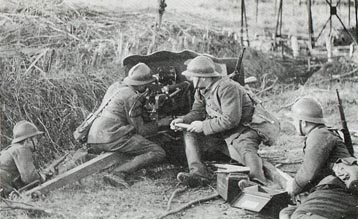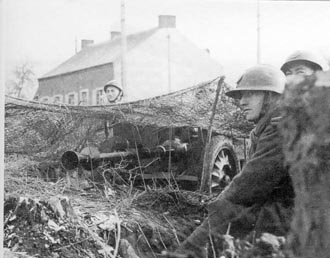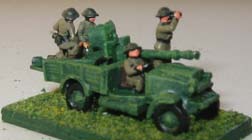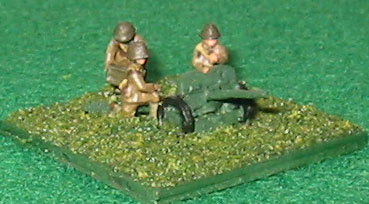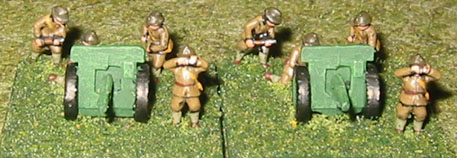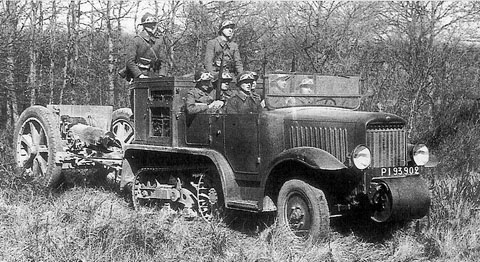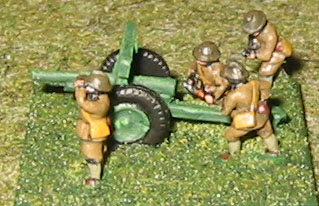|
Anti-Tank GunsIn 1940 the French had two modern anti-tank guns, the 25mm and the 47mm. Unfortunately there were not suficient to equip all the divisions and older WWI vintage guns were pressed into service.
The four types of anti-tank gun were: 25mm SA mle 34 and SA-L mle 37The Canon de 25 antichar SA modèle 1934 Hotchkiss and Canon de 25 antichar SA-L modèle 1937 Puteaux were the same gun mounted on two different carriages. The model 1937 had a lighter carriage weighing only two-thirds that of the earlier model 34 and the gun was very slightly longer.
The French 25mm AT guns were very modern when they came into service in 1934. In 1940 there were 4500 guns in service but this was insuficient to fully equip all units and some had WWI vintage 37mm guns instead. These light anti-tank guns were crewed by the infantry or cavalry and not by the artillery. The 25mm proved very accurate and had an effective range of 800m at which it could destroy all German tanks except the Panzer IV which the gunners needed to get at a closer range. The gun had a very small silluette and a good flash suppressor, a combination which made it very hard to spot.
Each 25mm AT gun in an infantry regiment had 156 AP/APT rounds of which 72 were immediately available. There was no HE shell for this gun so it could not be used against soft targets.
In non-motorised units the 25mm AT guns were generally towed behind a horse-drawn model 1937 limber. In combat the Renault UE tractor could be used to tow them. In motorized infantry regiments the towing vehicle was also often the Renault UE tractor and for long-range movements various halftracks and trucks were used. The original mle 1934 gun was designed to be horse-drawn and found to be too unstable for high speed towing by wheeled vehicles. They were therefore transported carried on a truck or towed behind on additional "wheels" (train rouleur). The lightened mle 1937 could be towed behind tractors. In the divisional AT company/squadron of motorized units the official towing vehicle could be the Laffly V15T in cavalry units or the Latil M7 T1 in infantry units. The Unic TU1 was also used for that task.
The 25mm anti-tank gun was very fragile and could not withstand prolonged towing by motor vehicles. It quickly became the practice for motorised units to carry their guns in the back of their vehicles. The dragoon regiments (RDP) in the Light Mechanised Division (DLM) soon mounted the 25mm guns belonging to their heavy weapons squadron in their Laffly S20TL trucks. The guns could be carried facing forwards or backwards and could be fired when mounted. When the gun faced forward the windscreen had to be lowered so Laffly produced a special vehicle with split windscreens that allowed the driver’s side to remain up with a forward facing gun.
About 220 of these guns were given to the British Expeditionnary Force (BEF) in exchange for some Boys AT-Rifles. The practice of carrying the gun on the bed of a truck was copied by the British and "Portee" became a British military term.
37mm mle 1916 TRPThe Canon d'Infanterie de 37 modèle 1916 TRP was an infantry support gun, first used during WWI. TR stands for tir rapide (rapid fire) and P for the manufacturer (Atelier de Puteaux). For transport this weapon could be broken down into 3 sections or wheels could be added for towing. These guns were sometimes equipped with an armored shield. 1036 of these guns are still in service in 1940 in the French army (mostly in second line infantry divisions) to perform as an anti-tank gun since there are not enough of the new 25mm AT guns in service to equip all the infantry regiments. In this role each gun had 120 HE and 80 AP shells available. The 25mm AT gun was lacking HE shells to neutralize human/soft targets and therefore the 37mm TR infantry gun was still liked since it could fire HE shells. Additionally it was very accurate and had a high rate of fire. 47mm SA mle 37The Canon de 47 antichar SA modèle 1937 Atelier Puteaux was arguably the best anti-tank gun on the battlefield in France 1940. Only the German 8,8 cm FlaK 18 had a better penetration but that gun's high silluette, poor maneuvrability and lack of gunshield made it unsuitable for the anti-tank role.
From 1918 to 1938, the French Army had employed the 75mm modèle 1897 field gun in the anti-tank role. Although this gun was an effective anti-tank weapon, it was too big, too heavy and too unmaneuvrable (6° traverse) to be a really effective anti-tank gun. In 1938, the French Artillery selected a 47mm gun manufactured by Atelier Puteaux as its new anti-tank gun, although problems with the prototype and ammunition delayed the start of production. In 1940 there were 1200 guns in service but this was insuficient to fully equip all units and some still had the WWI vintage 75mm modèle 1897 gun. Unlike the light anti-tank guns, these were crewed by the artillery. The 47mm was very accurate and had an effective range of 1000m at which it could destroy all German tanks. These guns were rarely horse-drawn and even in non-motorised units these guns were vehicle-towed. The Citroën-Kégresse P17, Unic P107, Laffly S15T or Laffly W15T were all possible tractors.
This gun was respected by the Germans and in his memoirs, "Achtung Panzer !", General Heinz Guderian describes how hed directed the fire of a captured French 47mm against an attacking Char B1 bis which the German's own 37mm anti-tank guns had problems penetrating. The 47 SA 37 also armed anti-tank vehicles such as the Laffly W15 TCC tank hunter (based on a 6x6 Laffly truck). By mid June 1940, 70 Laffly W15 TCCs had been produced, and their high mobility and firepower had allowed them to rack up a huge kill ratio. 75mm mle 1897 and 75mm mle 1897/33 and 75mm mle 1897/38In 1940 there were insuficient 47mm guns to equip the artillery's anti-tank units so WWI vintage 75mm guns were used instead. Sometimes units had a mix of 47mm and 75mm guns.
The canon de 75 mm mle 1897 was a field artillery piece from 1897 which served throughout WWI and continued to equip many horse-drawn field artillery units in 1940. It could be used against tanks but its limited 6° traverse made it less than ideally suited for this role..
The canon de 75 mm mle 1897 modifié 1933 was a
modified version with a new split-trail carriage that entered service
in 1935.
It was intended for the anti-tank role with a split trail
carriage designed by the Atelier de Bourges. This gave it a
much
wide traverse (58° instead of 6°) as well as an
improved
elevation (-6° to +50° instead of -11° to
+18°). The
weight was however increased (1,550 kg instead of 1,140 kg). In 1935 the Arbel platform was introduced; this was a simple circular grooved base that gave the gun a 360° field of fire, at the cost of increased time to limber and unlimber. It was not unlike the method used by the British on the 25pdr.
The canon de 75 mm mle 1897 modifié 1938 had the original wooden wheels replaced by metal wheels with tyres and the weight increased to 1,500kg. Owing to lack of time only 700 guns were modified and these were used to equip motorized artillery units. The tractor used to pull these guns was normally the UNIC P107 halftrack or Laffly S 15 TL truck.
On June 6th, 1940 at Hornoy, a battery of 75mm mle 1897 guns belonging to the 72nd Regiment of Artillery, claimed 38 German tanks destroyed in just one afternoon! Technical Data
| ||||||||||||||||||||||||||||||||||||||||||||||||||||||||||||||||||||||||||||||||||||||||||||||||||||||||||||||||||||||||||||||||||||||||||||||||||||||||||||||||||||||||||||||||||||||||


